Ethical Responsibilities for IKEA: Business Ethics and CSR Analysis
VerifiedAdded on 2019/10/31
|14
|4208
|646
Report
AI Summary
This report provides an in-depth analysis of IKEA's ethical responsibilities, focusing on its past ethical issues, corporate social responsibility (CSR) practices, and treatment of stakeholders. It examines IKEA's vision, mission, and code of practice, highlighting how these elements influence the company's operations. The report investigates specific ethical challenges IKEA has faced, such as employee surveillance, the use of political prisoner labor, and product quality issues. It applies Carroll's CSR model to assess IKEA's economic, legal, ethical, and philanthropic responsibilities. The analysis reveals IKEA's primary customer-centric approach aimed at providing affordable products while addressing sustainability and ethical sourcing. The report concludes with recommendations for IKEA to enhance its ethical practices and improve stakeholder relations, providing a comprehensive overview of the company's commitment to ethical conduct and social responsibility.
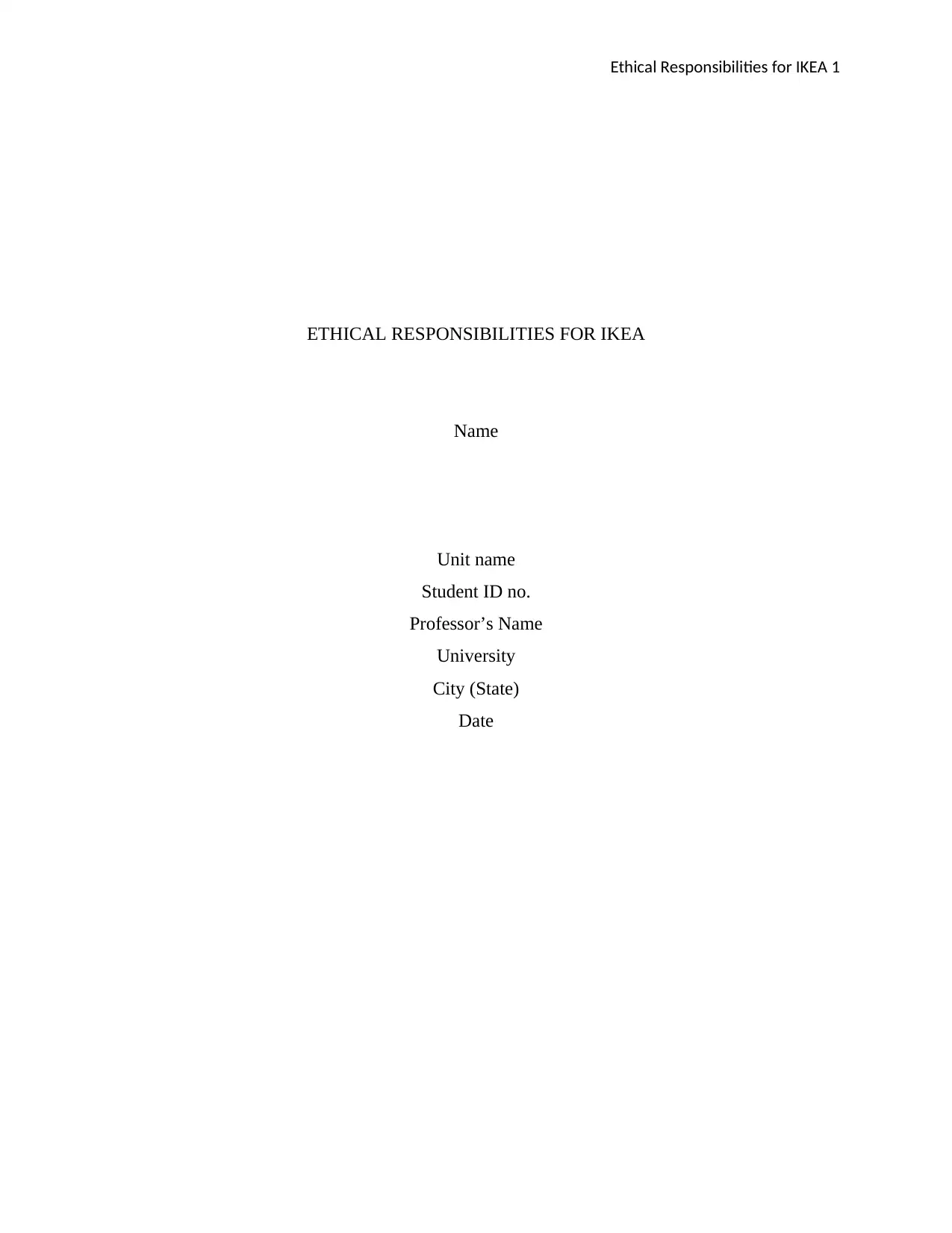
Ethical Responsibilities for IKEA 1
ETHICAL RESPONSIBILITIES FOR IKEA
Name
Unit name
Student ID no.
Professor’s Name
University
City (State)
Date
ETHICAL RESPONSIBILITIES FOR IKEA
Name
Unit name
Student ID no.
Professor’s Name
University
City (State)
Date
Paraphrase This Document
Need a fresh take? Get an instant paraphrase of this document with our AI Paraphraser
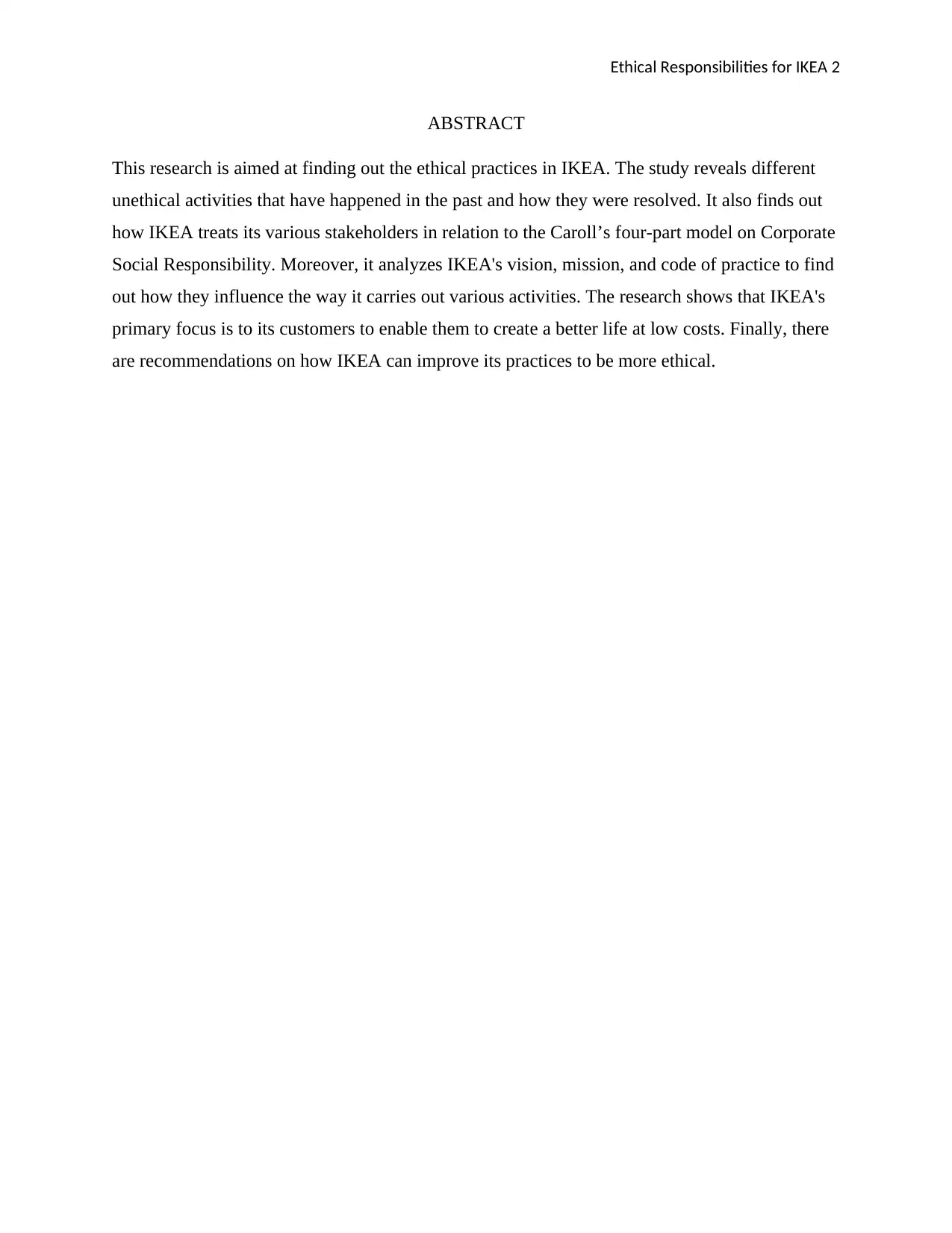
Ethical Responsibilities for IKEA 2
ABSTRACT
This research is aimed at finding out the ethical practices in IKEA. The study reveals different
unethical activities that have happened in the past and how they were resolved. It also finds out
how IKEA treats its various stakeholders in relation to the Caroll’s four-part model on Corporate
Social Responsibility. Moreover, it analyzes IKEA's vision, mission, and code of practice to find
out how they influence the way it carries out various activities. The research shows that IKEA's
primary focus is to its customers to enable them to create a better life at low costs. Finally, there
are recommendations on how IKEA can improve its practices to be more ethical.
ABSTRACT
This research is aimed at finding out the ethical practices in IKEA. The study reveals different
unethical activities that have happened in the past and how they were resolved. It also finds out
how IKEA treats its various stakeholders in relation to the Caroll’s four-part model on Corporate
Social Responsibility. Moreover, it analyzes IKEA's vision, mission, and code of practice to find
out how they influence the way it carries out various activities. The research shows that IKEA's
primary focus is to its customers to enable them to create a better life at low costs. Finally, there
are recommendations on how IKEA can improve its practices to be more ethical.
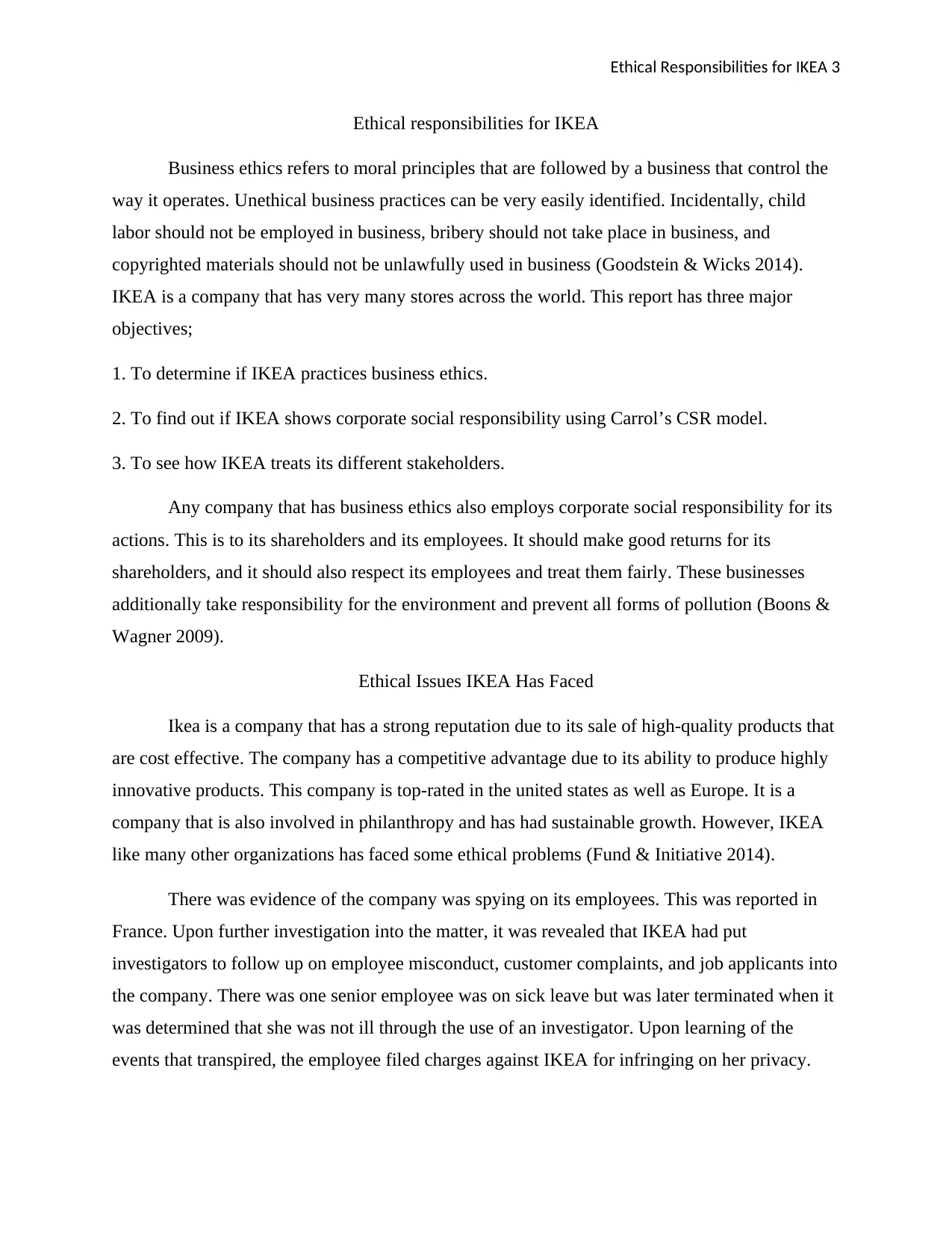
Ethical Responsibilities for IKEA 3
Ethical responsibilities for IKEA
Business ethics refers to moral principles that are followed by a business that control the
way it operates. Unethical business practices can be very easily identified. Incidentally, child
labor should not be employed in business, bribery should not take place in business, and
copyrighted materials should not be unlawfully used in business (Goodstein & Wicks 2014).
IKEA is a company that has very many stores across the world. This report has three major
objectives;
1. To determine if IKEA practices business ethics.
2. To find out if IKEA shows corporate social responsibility using Carrol’s CSR model.
3. To see how IKEA treats its different stakeholders.
Any company that has business ethics also employs corporate social responsibility for its
actions. This is to its shareholders and its employees. It should make good returns for its
shareholders, and it should also respect its employees and treat them fairly. These businesses
additionally take responsibility for the environment and prevent all forms of pollution (Boons &
Wagner 2009).
Ethical Issues IKEA Has Faced
Ikea is a company that has a strong reputation due to its sale of high-quality products that
are cost effective. The company has a competitive advantage due to its ability to produce highly
innovative products. This company is top-rated in the united states as well as Europe. It is a
company that is also involved in philanthropy and has had sustainable growth. However, IKEA
like many other organizations has faced some ethical problems (Fund & Initiative 2014).
There was evidence of the company was spying on its employees. This was reported in
France. Upon further investigation into the matter, it was revealed that IKEA had put
investigators to follow up on employee misconduct, customer complaints, and job applicants into
the company. There was one senior employee was on sick leave but was later terminated when it
was determined that she was not ill through the use of an investigator. Upon learning of the
events that transpired, the employee filed charges against IKEA for infringing on her privacy.
Ethical responsibilities for IKEA
Business ethics refers to moral principles that are followed by a business that control the
way it operates. Unethical business practices can be very easily identified. Incidentally, child
labor should not be employed in business, bribery should not take place in business, and
copyrighted materials should not be unlawfully used in business (Goodstein & Wicks 2014).
IKEA is a company that has very many stores across the world. This report has three major
objectives;
1. To determine if IKEA practices business ethics.
2. To find out if IKEA shows corporate social responsibility using Carrol’s CSR model.
3. To see how IKEA treats its different stakeholders.
Any company that has business ethics also employs corporate social responsibility for its
actions. This is to its shareholders and its employees. It should make good returns for its
shareholders, and it should also respect its employees and treat them fairly. These businesses
additionally take responsibility for the environment and prevent all forms of pollution (Boons &
Wagner 2009).
Ethical Issues IKEA Has Faced
Ikea is a company that has a strong reputation due to its sale of high-quality products that
are cost effective. The company has a competitive advantage due to its ability to produce highly
innovative products. This company is top-rated in the united states as well as Europe. It is a
company that is also involved in philanthropy and has had sustainable growth. However, IKEA
like many other organizations has faced some ethical problems (Fund & Initiative 2014).
There was evidence of the company was spying on its employees. This was reported in
France. Upon further investigation into the matter, it was revealed that IKEA had put
investigators to follow up on employee misconduct, customer complaints, and job applicants into
the company. There was one senior employee was on sick leave but was later terminated when it
was determined that she was not ill through the use of an investigator. Upon learning of the
events that transpired, the employee filed charges against IKEA for infringing on her privacy.
⊘ This is a preview!⊘
Do you want full access?
Subscribe today to unlock all pages.

Trusted by 1+ million students worldwide
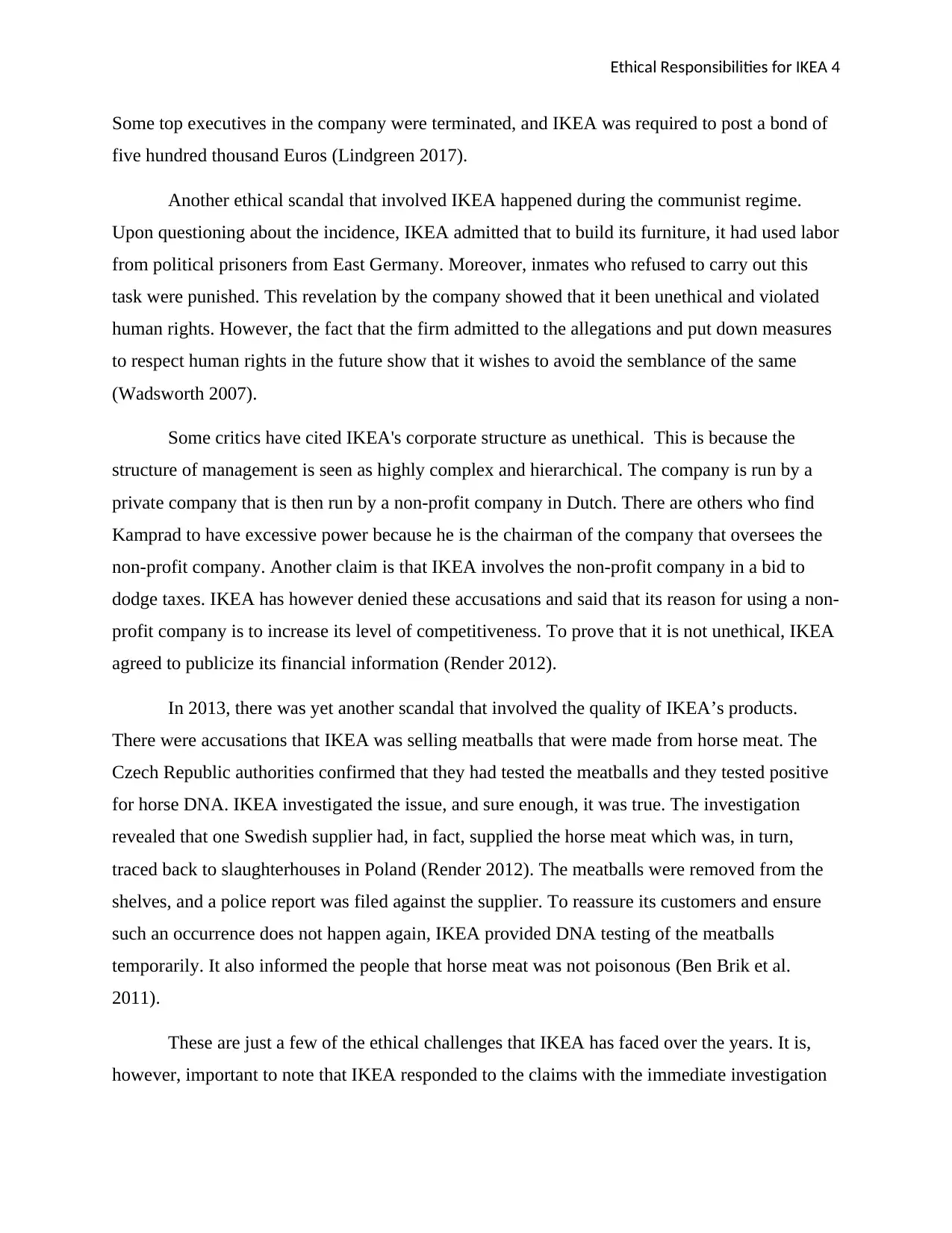
Ethical Responsibilities for IKEA 4
Some top executives in the company were terminated, and IKEA was required to post a bond of
five hundred thousand Euros (Lindgreen 2017).
Another ethical scandal that involved IKEA happened during the communist regime.
Upon questioning about the incidence, IKEA admitted that to build its furniture, it had used labor
from political prisoners from East Germany. Moreover, inmates who refused to carry out this
task were punished. This revelation by the company showed that it been unethical and violated
human rights. However, the fact that the firm admitted to the allegations and put down measures
to respect human rights in the future show that it wishes to avoid the semblance of the same
(Wadsworth 2007).
Some critics have cited IKEA's corporate structure as unethical. This is because the
structure of management is seen as highly complex and hierarchical. The company is run by a
private company that is then run by a non-profit company in Dutch. There are others who find
Kamprad to have excessive power because he is the chairman of the company that oversees the
non-profit company. Another claim is that IKEA involves the non-profit company in a bid to
dodge taxes. IKEA has however denied these accusations and said that its reason for using a non-
profit company is to increase its level of competitiveness. To prove that it is not unethical, IKEA
agreed to publicize its financial information (Render 2012).
In 2013, there was yet another scandal that involved the quality of IKEA’s products.
There were accusations that IKEA was selling meatballs that were made from horse meat. The
Czech Republic authorities confirmed that they had tested the meatballs and they tested positive
for horse DNA. IKEA investigated the issue, and sure enough, it was true. The investigation
revealed that one Swedish supplier had, in fact, supplied the horse meat which was, in turn,
traced back to slaughterhouses in Poland (Render 2012). The meatballs were removed from the
shelves, and a police report was filed against the supplier. To reassure its customers and ensure
such an occurrence does not happen again, IKEA provided DNA testing of the meatballs
temporarily. It also informed the people that horse meat was not poisonous (Ben Brik et al.
2011).
These are just a few of the ethical challenges that IKEA has faced over the years. It is,
however, important to note that IKEA responded to the claims with the immediate investigation
Some top executives in the company were terminated, and IKEA was required to post a bond of
five hundred thousand Euros (Lindgreen 2017).
Another ethical scandal that involved IKEA happened during the communist regime.
Upon questioning about the incidence, IKEA admitted that to build its furniture, it had used labor
from political prisoners from East Germany. Moreover, inmates who refused to carry out this
task were punished. This revelation by the company showed that it been unethical and violated
human rights. However, the fact that the firm admitted to the allegations and put down measures
to respect human rights in the future show that it wishes to avoid the semblance of the same
(Wadsworth 2007).
Some critics have cited IKEA's corporate structure as unethical. This is because the
structure of management is seen as highly complex and hierarchical. The company is run by a
private company that is then run by a non-profit company in Dutch. There are others who find
Kamprad to have excessive power because he is the chairman of the company that oversees the
non-profit company. Another claim is that IKEA involves the non-profit company in a bid to
dodge taxes. IKEA has however denied these accusations and said that its reason for using a non-
profit company is to increase its level of competitiveness. To prove that it is not unethical, IKEA
agreed to publicize its financial information (Render 2012).
In 2013, there was yet another scandal that involved the quality of IKEA’s products.
There were accusations that IKEA was selling meatballs that were made from horse meat. The
Czech Republic authorities confirmed that they had tested the meatballs and they tested positive
for horse DNA. IKEA investigated the issue, and sure enough, it was true. The investigation
revealed that one Swedish supplier had, in fact, supplied the horse meat which was, in turn,
traced back to slaughterhouses in Poland (Render 2012). The meatballs were removed from the
shelves, and a police report was filed against the supplier. To reassure its customers and ensure
such an occurrence does not happen again, IKEA provided DNA testing of the meatballs
temporarily. It also informed the people that horse meat was not poisonous (Ben Brik et al.
2011).
These are just a few of the ethical challenges that IKEA has faced over the years. It is,
however, important to note that IKEA responded to the claims with the immediate investigation
Paraphrase This Document
Need a fresh take? Get an instant paraphrase of this document with our AI Paraphraser
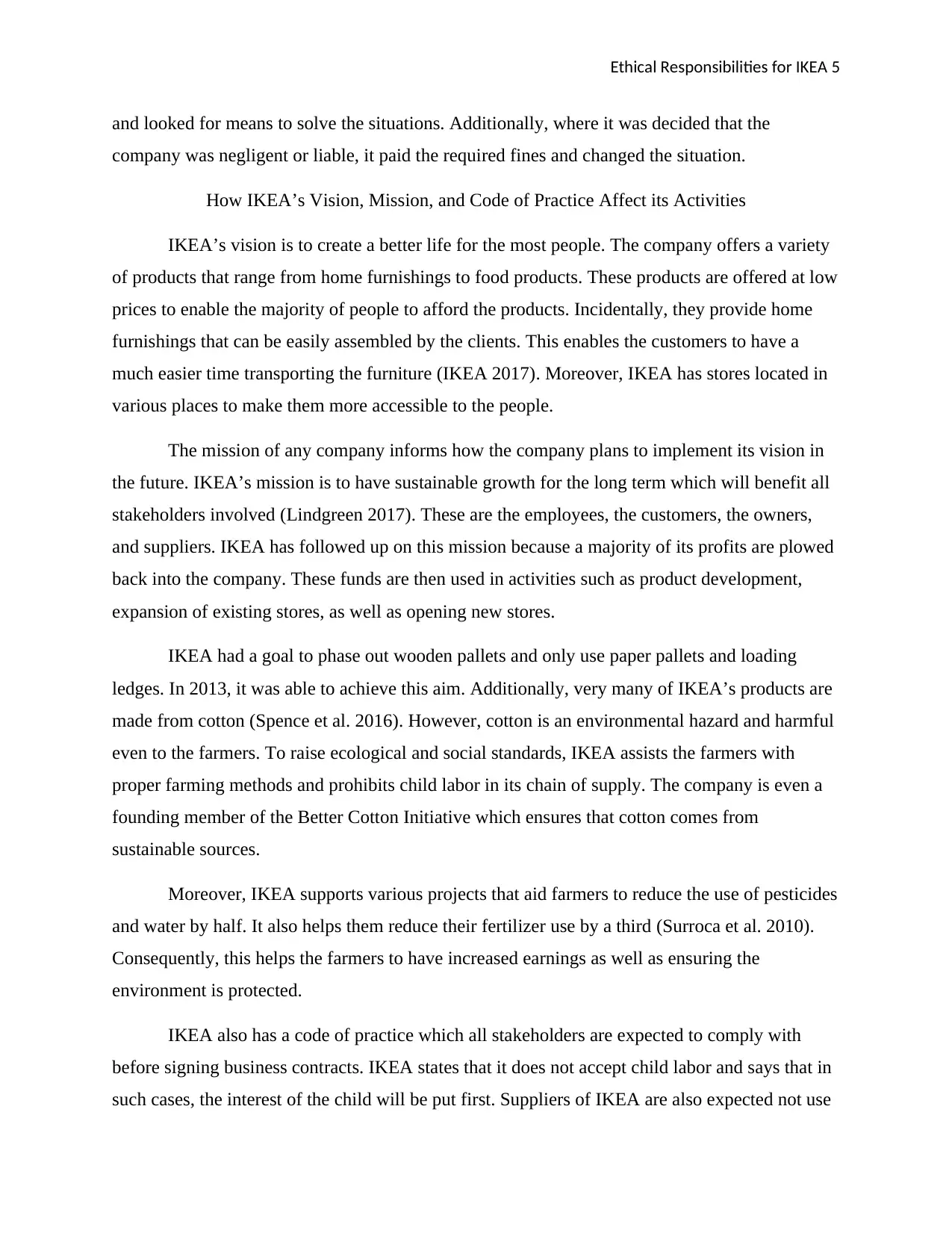
Ethical Responsibilities for IKEA 5
and looked for means to solve the situations. Additionally, where it was decided that the
company was negligent or liable, it paid the required fines and changed the situation.
How IKEA’s Vision, Mission, and Code of Practice Affect its Activities
IKEA’s vision is to create a better life for the most people. The company offers a variety
of products that range from home furnishings to food products. These products are offered at low
prices to enable the majority of people to afford the products. Incidentally, they provide home
furnishings that can be easily assembled by the clients. This enables the customers to have a
much easier time transporting the furniture (IKEA 2017). Moreover, IKEA has stores located in
various places to make them more accessible to the people.
The mission of any company informs how the company plans to implement its vision in
the future. IKEA’s mission is to have sustainable growth for the long term which will benefit all
stakeholders involved (Lindgreen 2017). These are the employees, the customers, the owners,
and suppliers. IKEA has followed up on this mission because a majority of its profits are plowed
back into the company. These funds are then used in activities such as product development,
expansion of existing stores, as well as opening new stores.
IKEA had a goal to phase out wooden pallets and only use paper pallets and loading
ledges. In 2013, it was able to achieve this aim. Additionally, very many of IKEA’s products are
made from cotton (Spence et al. 2016). However, cotton is an environmental hazard and harmful
even to the farmers. To raise ecological and social standards, IKEA assists the farmers with
proper farming methods and prohibits child labor in its chain of supply. The company is even a
founding member of the Better Cotton Initiative which ensures that cotton comes from
sustainable sources.
Moreover, IKEA supports various projects that aid farmers to reduce the use of pesticides
and water by half. It also helps them reduce their fertilizer use by a third (Surroca et al. 2010).
Consequently, this helps the farmers to have increased earnings as well as ensuring the
environment is protected.
IKEA also has a code of practice which all stakeholders are expected to comply with
before signing business contracts. IKEA states that it does not accept child labor and says that in
such cases, the interest of the child will be put first. Suppliers of IKEA are also expected not use
and looked for means to solve the situations. Additionally, where it was decided that the
company was negligent or liable, it paid the required fines and changed the situation.
How IKEA’s Vision, Mission, and Code of Practice Affect its Activities
IKEA’s vision is to create a better life for the most people. The company offers a variety
of products that range from home furnishings to food products. These products are offered at low
prices to enable the majority of people to afford the products. Incidentally, they provide home
furnishings that can be easily assembled by the clients. This enables the customers to have a
much easier time transporting the furniture (IKEA 2017). Moreover, IKEA has stores located in
various places to make them more accessible to the people.
The mission of any company informs how the company plans to implement its vision in
the future. IKEA’s mission is to have sustainable growth for the long term which will benefit all
stakeholders involved (Lindgreen 2017). These are the employees, the customers, the owners,
and suppliers. IKEA has followed up on this mission because a majority of its profits are plowed
back into the company. These funds are then used in activities such as product development,
expansion of existing stores, as well as opening new stores.
IKEA had a goal to phase out wooden pallets and only use paper pallets and loading
ledges. In 2013, it was able to achieve this aim. Additionally, very many of IKEA’s products are
made from cotton (Spence et al. 2016). However, cotton is an environmental hazard and harmful
even to the farmers. To raise ecological and social standards, IKEA assists the farmers with
proper farming methods and prohibits child labor in its chain of supply. The company is even a
founding member of the Better Cotton Initiative which ensures that cotton comes from
sustainable sources.
Moreover, IKEA supports various projects that aid farmers to reduce the use of pesticides
and water by half. It also helps them reduce their fertilizer use by a third (Surroca et al. 2010).
Consequently, this helps the farmers to have increased earnings as well as ensuring the
environment is protected.
IKEA also has a code of practice which all stakeholders are expected to comply with
before signing business contracts. IKEA states that it does not accept child labor and says that in
such cases, the interest of the child will be put first. Suppliers of IKEA are also expected not use
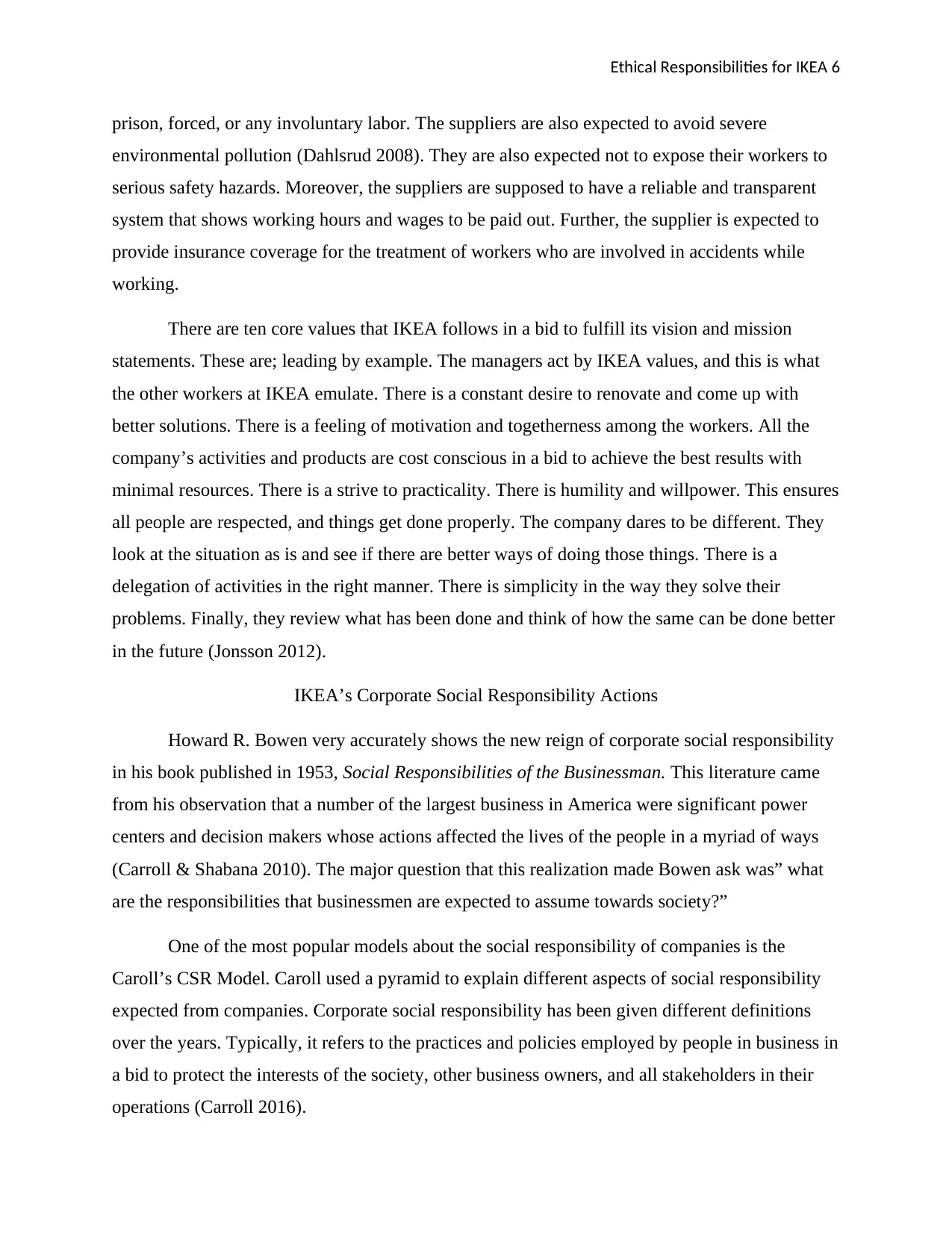
Ethical Responsibilities for IKEA 6
prison, forced, or any involuntary labor. The suppliers are also expected to avoid severe
environmental pollution (Dahlsrud 2008). They are also expected not to expose their workers to
serious safety hazards. Moreover, the suppliers are supposed to have a reliable and transparent
system that shows working hours and wages to be paid out. Further, the supplier is expected to
provide insurance coverage for the treatment of workers who are involved in accidents while
working.
There are ten core values that IKEA follows in a bid to fulfill its vision and mission
statements. These are; leading by example. The managers act by IKEA values, and this is what
the other workers at IKEA emulate. There is a constant desire to renovate and come up with
better solutions. There is a feeling of motivation and togetherness among the workers. All the
company’s activities and products are cost conscious in a bid to achieve the best results with
minimal resources. There is a strive to practicality. There is humility and willpower. This ensures
all people are respected, and things get done properly. The company dares to be different. They
look at the situation as is and see if there are better ways of doing those things. There is a
delegation of activities in the right manner. There is simplicity in the way they solve their
problems. Finally, they review what has been done and think of how the same can be done better
in the future (Jonsson 2012).
IKEA’s Corporate Social Responsibility Actions
Howard R. Bowen very accurately shows the new reign of corporate social responsibility
in his book published in 1953, Social Responsibilities of the Businessman. This literature came
from his observation that a number of the largest business in America were significant power
centers and decision makers whose actions affected the lives of the people in a myriad of ways
(Carroll & Shabana 2010). The major question that this realization made Bowen ask was” what
are the responsibilities that businessmen are expected to assume towards society?”
One of the most popular models about the social responsibility of companies is the
Caroll’s CSR Model. Caroll used a pyramid to explain different aspects of social responsibility
expected from companies. Corporate social responsibility has been given different definitions
over the years. Typically, it refers to the practices and policies employed by people in business in
a bid to protect the interests of the society, other business owners, and all stakeholders in their
operations (Carroll 2016).
prison, forced, or any involuntary labor. The suppliers are also expected to avoid severe
environmental pollution (Dahlsrud 2008). They are also expected not to expose their workers to
serious safety hazards. Moreover, the suppliers are supposed to have a reliable and transparent
system that shows working hours and wages to be paid out. Further, the supplier is expected to
provide insurance coverage for the treatment of workers who are involved in accidents while
working.
There are ten core values that IKEA follows in a bid to fulfill its vision and mission
statements. These are; leading by example. The managers act by IKEA values, and this is what
the other workers at IKEA emulate. There is a constant desire to renovate and come up with
better solutions. There is a feeling of motivation and togetherness among the workers. All the
company’s activities and products are cost conscious in a bid to achieve the best results with
minimal resources. There is a strive to practicality. There is humility and willpower. This ensures
all people are respected, and things get done properly. The company dares to be different. They
look at the situation as is and see if there are better ways of doing those things. There is a
delegation of activities in the right manner. There is simplicity in the way they solve their
problems. Finally, they review what has been done and think of how the same can be done better
in the future (Jonsson 2012).
IKEA’s Corporate Social Responsibility Actions
Howard R. Bowen very accurately shows the new reign of corporate social responsibility
in his book published in 1953, Social Responsibilities of the Businessman. This literature came
from his observation that a number of the largest business in America were significant power
centers and decision makers whose actions affected the lives of the people in a myriad of ways
(Carroll & Shabana 2010). The major question that this realization made Bowen ask was” what
are the responsibilities that businessmen are expected to assume towards society?”
One of the most popular models about the social responsibility of companies is the
Caroll’s CSR Model. Caroll used a pyramid to explain different aspects of social responsibility
expected from companies. Corporate social responsibility has been given different definitions
over the years. Typically, it refers to the practices and policies employed by people in business in
a bid to protect the interests of the society, other business owners, and all stakeholders in their
operations (Carroll 2016).
⊘ This is a preview!⊘
Do you want full access?
Subscribe today to unlock all pages.

Trusted by 1+ million students worldwide
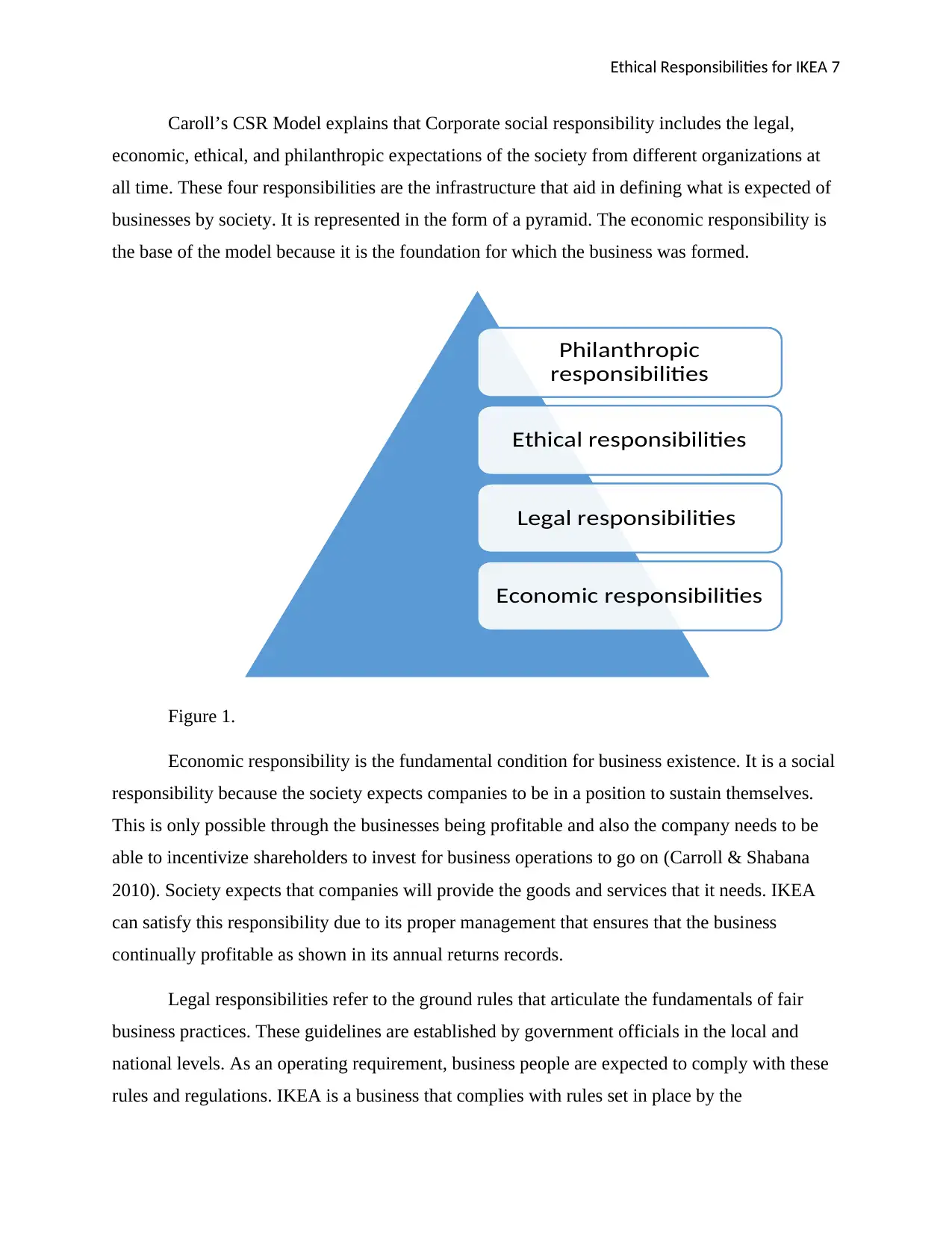
Ethical Responsibilities for IKEA 7
Caroll’s CSR Model explains that Corporate social responsibility includes the legal,
economic, ethical, and philanthropic expectations of the society from different organizations at
all time. These four responsibilities are the infrastructure that aid in defining what is expected of
businesses by society. It is represented in the form of a pyramid. The economic responsibility is
the base of the model because it is the foundation for which the business was formed.
Figure 1.
Economic responsibility is the fundamental condition for business existence. It is a social
responsibility because the society expects companies to be in a position to sustain themselves.
This is only possible through the businesses being profitable and also the company needs to be
able to incentivize shareholders to invest for business operations to go on (Carroll & Shabana
2010). Society expects that companies will provide the goods and services that it needs. IKEA
can satisfy this responsibility due to its proper management that ensures that the business
continually profitable as shown in its annual returns records.
Legal responsibilities refer to the ground rules that articulate the fundamentals of fair
business practices. These guidelines are established by government officials in the local and
national levels. As an operating requirement, business people are expected to comply with these
rules and regulations. IKEA is a business that complies with rules set in place by the
Philanthropic
responsibilities
Ethical responsibilities
Legal responsibilities
Economic responsibilities
Caroll’s CSR Model explains that Corporate social responsibility includes the legal,
economic, ethical, and philanthropic expectations of the society from different organizations at
all time. These four responsibilities are the infrastructure that aid in defining what is expected of
businesses by society. It is represented in the form of a pyramid. The economic responsibility is
the base of the model because it is the foundation for which the business was formed.
Figure 1.
Economic responsibility is the fundamental condition for business existence. It is a social
responsibility because the society expects companies to be in a position to sustain themselves.
This is only possible through the businesses being profitable and also the company needs to be
able to incentivize shareholders to invest for business operations to go on (Carroll & Shabana
2010). Society expects that companies will provide the goods and services that it needs. IKEA
can satisfy this responsibility due to its proper management that ensures that the business
continually profitable as shown in its annual returns records.
Legal responsibilities refer to the ground rules that articulate the fundamentals of fair
business practices. These guidelines are established by government officials in the local and
national levels. As an operating requirement, business people are expected to comply with these
rules and regulations. IKEA is a business that complies with rules set in place by the
Philanthropic
responsibilities
Ethical responsibilities
Legal responsibilities
Economic responsibilities
Paraphrase This Document
Need a fresh take? Get an instant paraphrase of this document with our AI Paraphraser
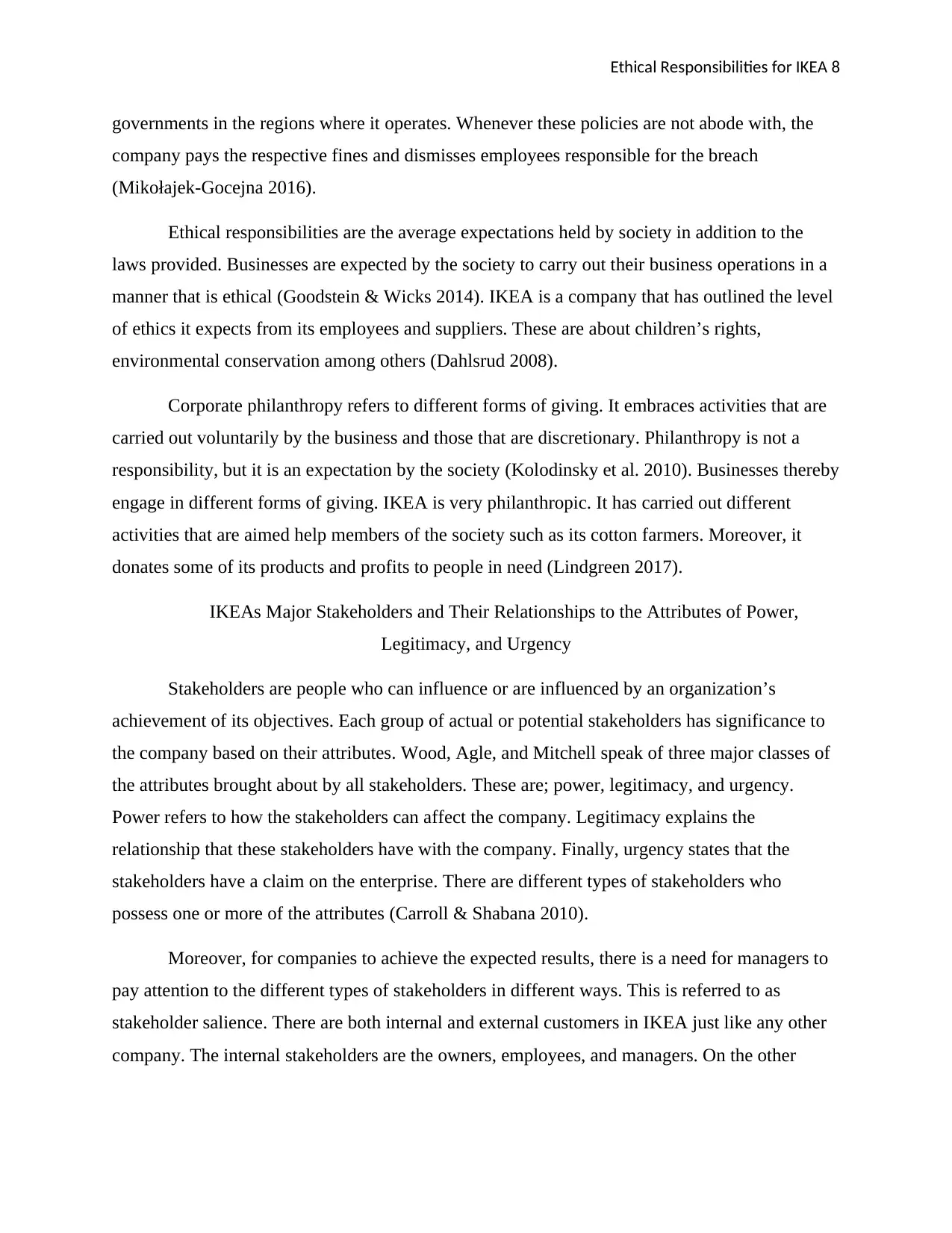
Ethical Responsibilities for IKEA 8
governments in the regions where it operates. Whenever these policies are not abode with, the
company pays the respective fines and dismisses employees responsible for the breach
(Mikołajek-Gocejna 2016).
Ethical responsibilities are the average expectations held by society in addition to the
laws provided. Businesses are expected by the society to carry out their business operations in a
manner that is ethical (Goodstein & Wicks 2014). IKEA is a company that has outlined the level
of ethics it expects from its employees and suppliers. These are about children’s rights,
environmental conservation among others (Dahlsrud 2008).
Corporate philanthropy refers to different forms of giving. It embraces activities that are
carried out voluntarily by the business and those that are discretionary. Philanthropy is not a
responsibility, but it is an expectation by the society (Kolodinsky et al. 2010). Businesses thereby
engage in different forms of giving. IKEA is very philanthropic. It has carried out different
activities that are aimed help members of the society such as its cotton farmers. Moreover, it
donates some of its products and profits to people in need (Lindgreen 2017).
IKEAs Major Stakeholders and Their Relationships to the Attributes of Power,
Legitimacy, and Urgency
Stakeholders are people who can influence or are influenced by an organization’s
achievement of its objectives. Each group of actual or potential stakeholders has significance to
the company based on their attributes. Wood, Agle, and Mitchell speak of three major classes of
the attributes brought about by all stakeholders. These are; power, legitimacy, and urgency.
Power refers to how the stakeholders can affect the company. Legitimacy explains the
relationship that these stakeholders have with the company. Finally, urgency states that the
stakeholders have a claim on the enterprise. There are different types of stakeholders who
possess one or more of the attributes (Carroll & Shabana 2010).
Moreover, for companies to achieve the expected results, there is a need for managers to
pay attention to the different types of stakeholders in different ways. This is referred to as
stakeholder salience. There are both internal and external customers in IKEA just like any other
company. The internal stakeholders are the owners, employees, and managers. On the other
governments in the regions where it operates. Whenever these policies are not abode with, the
company pays the respective fines and dismisses employees responsible for the breach
(Mikołajek-Gocejna 2016).
Ethical responsibilities are the average expectations held by society in addition to the
laws provided. Businesses are expected by the society to carry out their business operations in a
manner that is ethical (Goodstein & Wicks 2014). IKEA is a company that has outlined the level
of ethics it expects from its employees and suppliers. These are about children’s rights,
environmental conservation among others (Dahlsrud 2008).
Corporate philanthropy refers to different forms of giving. It embraces activities that are
carried out voluntarily by the business and those that are discretionary. Philanthropy is not a
responsibility, but it is an expectation by the society (Kolodinsky et al. 2010). Businesses thereby
engage in different forms of giving. IKEA is very philanthropic. It has carried out different
activities that are aimed help members of the society such as its cotton farmers. Moreover, it
donates some of its products and profits to people in need (Lindgreen 2017).
IKEAs Major Stakeholders and Their Relationships to the Attributes of Power,
Legitimacy, and Urgency
Stakeholders are people who can influence or are influenced by an organization’s
achievement of its objectives. Each group of actual or potential stakeholders has significance to
the company based on their attributes. Wood, Agle, and Mitchell speak of three major classes of
the attributes brought about by all stakeholders. These are; power, legitimacy, and urgency.
Power refers to how the stakeholders can affect the company. Legitimacy explains the
relationship that these stakeholders have with the company. Finally, urgency states that the
stakeholders have a claim on the enterprise. There are different types of stakeholders who
possess one or more of the attributes (Carroll & Shabana 2010).
Moreover, for companies to achieve the expected results, there is a need for managers to
pay attention to the different types of stakeholders in different ways. This is referred to as
stakeholder salience. There are both internal and external customers in IKEA just like any other
company. The internal stakeholders are the owners, employees, and managers. On the other
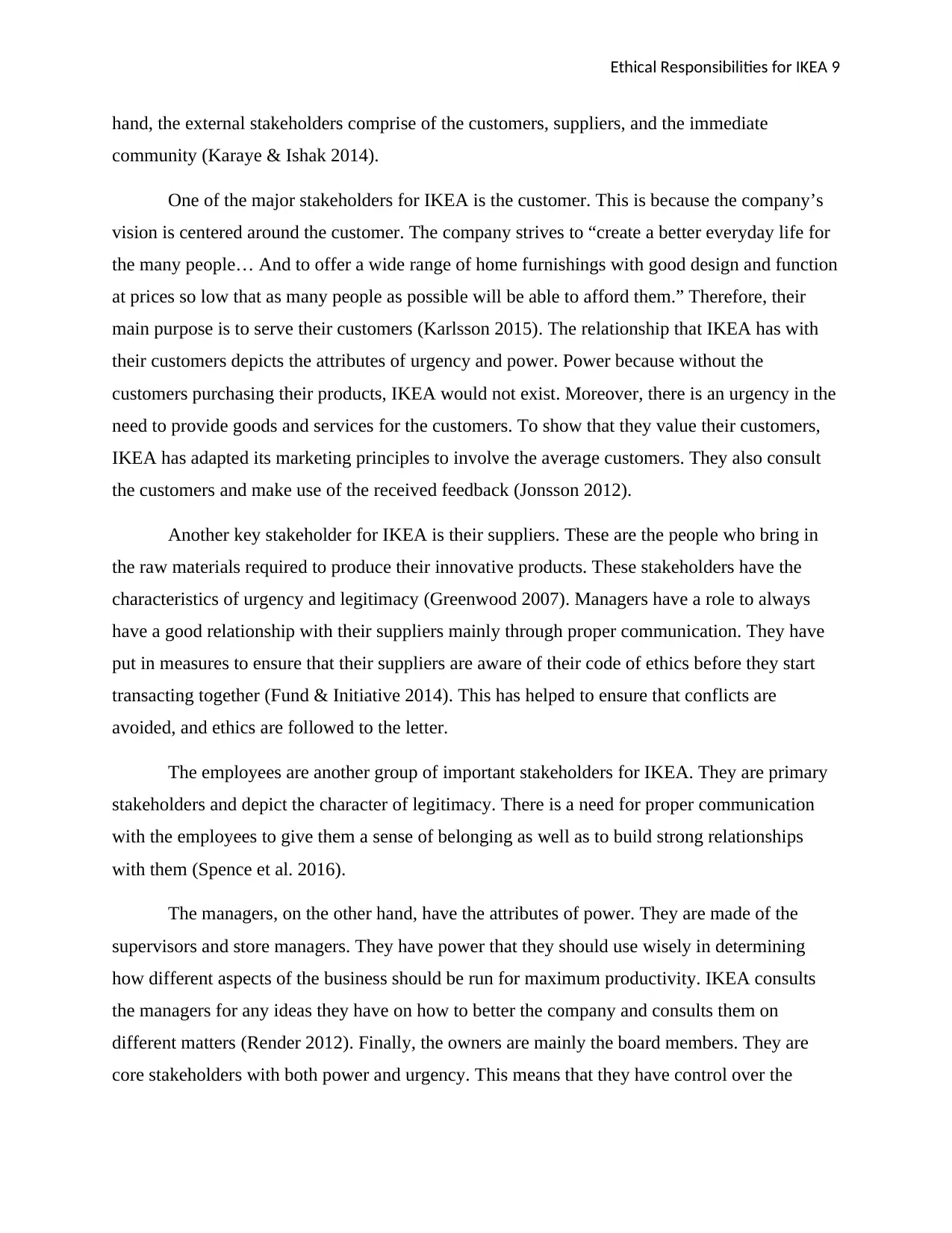
Ethical Responsibilities for IKEA 9
hand, the external stakeholders comprise of the customers, suppliers, and the immediate
community (Karaye & Ishak 2014).
One of the major stakeholders for IKEA is the customer. This is because the company’s
vision is centered around the customer. The company strives to “create a better everyday life for
the many people… And to offer a wide range of home furnishings with good design and function
at prices so low that as many people as possible will be able to afford them.” Therefore, their
main purpose is to serve their customers (Karlsson 2015). The relationship that IKEA has with
their customers depicts the attributes of urgency and power. Power because without the
customers purchasing their products, IKEA would not exist. Moreover, there is an urgency in the
need to provide goods and services for the customers. To show that they value their customers,
IKEA has adapted its marketing principles to involve the average customers. They also consult
the customers and make use of the received feedback (Jonsson 2012).
Another key stakeholder for IKEA is their suppliers. These are the people who bring in
the raw materials required to produce their innovative products. These stakeholders have the
characteristics of urgency and legitimacy (Greenwood 2007). Managers have a role to always
have a good relationship with their suppliers mainly through proper communication. They have
put in measures to ensure that their suppliers are aware of their code of ethics before they start
transacting together (Fund & Initiative 2014). This has helped to ensure that conflicts are
avoided, and ethics are followed to the letter.
The employees are another group of important stakeholders for IKEA. They are primary
stakeholders and depict the character of legitimacy. There is a need for proper communication
with the employees to give them a sense of belonging as well as to build strong relationships
with them (Spence et al. 2016).
The managers, on the other hand, have the attributes of power. They are made of the
supervisors and store managers. They have power that they should use wisely in determining
how different aspects of the business should be run for maximum productivity. IKEA consults
the managers for any ideas they have on how to better the company and consults them on
different matters (Render 2012). Finally, the owners are mainly the board members. They are
core stakeholders with both power and urgency. This means that they have control over the
hand, the external stakeholders comprise of the customers, suppliers, and the immediate
community (Karaye & Ishak 2014).
One of the major stakeholders for IKEA is the customer. This is because the company’s
vision is centered around the customer. The company strives to “create a better everyday life for
the many people… And to offer a wide range of home furnishings with good design and function
at prices so low that as many people as possible will be able to afford them.” Therefore, their
main purpose is to serve their customers (Karlsson 2015). The relationship that IKEA has with
their customers depicts the attributes of urgency and power. Power because without the
customers purchasing their products, IKEA would not exist. Moreover, there is an urgency in the
need to provide goods and services for the customers. To show that they value their customers,
IKEA has adapted its marketing principles to involve the average customers. They also consult
the customers and make use of the received feedback (Jonsson 2012).
Another key stakeholder for IKEA is their suppliers. These are the people who bring in
the raw materials required to produce their innovative products. These stakeholders have the
characteristics of urgency and legitimacy (Greenwood 2007). Managers have a role to always
have a good relationship with their suppliers mainly through proper communication. They have
put in measures to ensure that their suppliers are aware of their code of ethics before they start
transacting together (Fund & Initiative 2014). This has helped to ensure that conflicts are
avoided, and ethics are followed to the letter.
The employees are another group of important stakeholders for IKEA. They are primary
stakeholders and depict the character of legitimacy. There is a need for proper communication
with the employees to give them a sense of belonging as well as to build strong relationships
with them (Spence et al. 2016).
The managers, on the other hand, have the attributes of power. They are made of the
supervisors and store managers. They have power that they should use wisely in determining
how different aspects of the business should be run for maximum productivity. IKEA consults
the managers for any ideas they have on how to better the company and consults them on
different matters (Render 2012). Finally, the owners are mainly the board members. They are
core stakeholders with both power and urgency. This means that they have control over the
⊘ This is a preview!⊘
Do you want full access?
Subscribe today to unlock all pages.

Trusted by 1+ million students worldwide
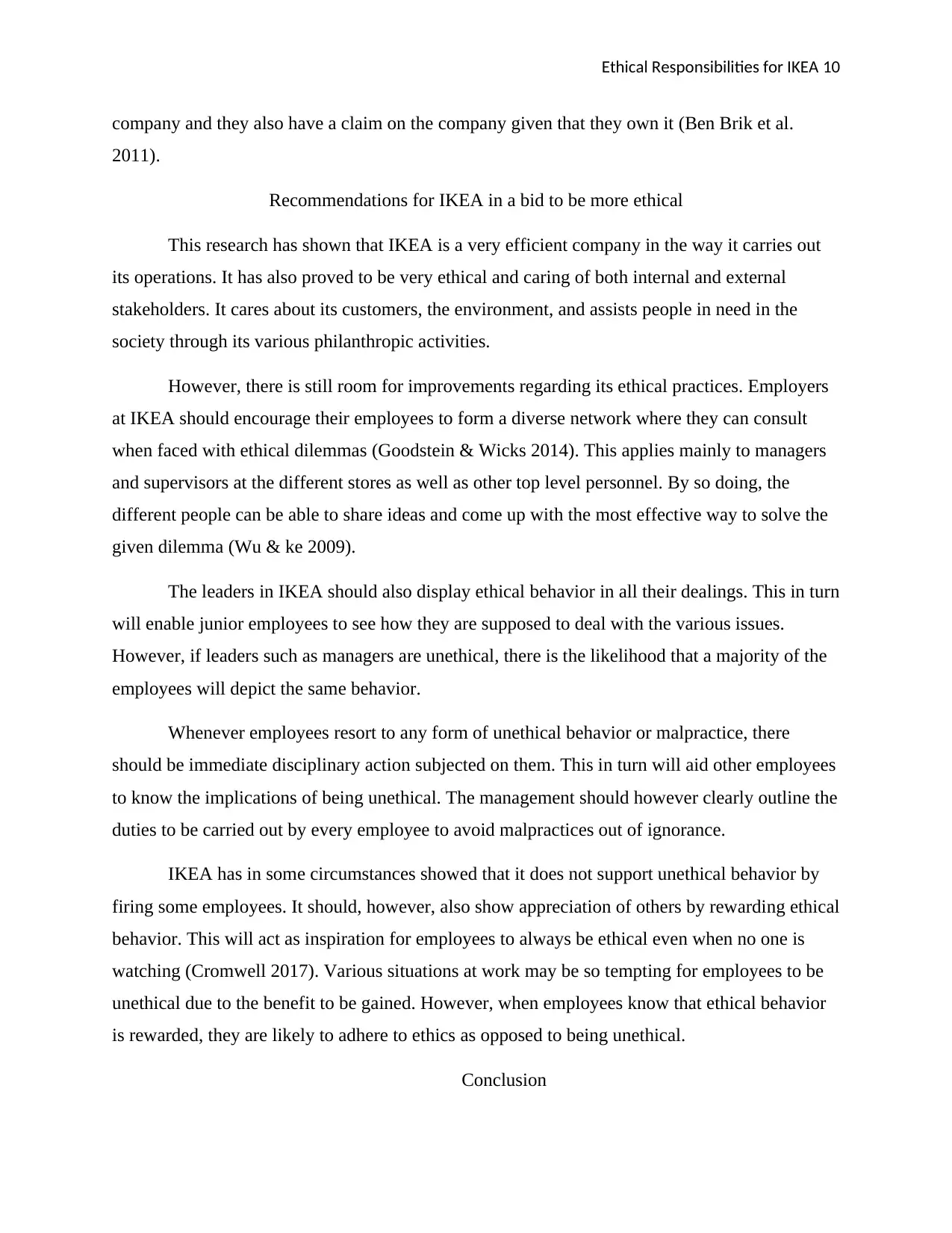
Ethical Responsibilities for IKEA 10
company and they also have a claim on the company given that they own it (Ben Brik et al.
2011).
Recommendations for IKEA in a bid to be more ethical
This research has shown that IKEA is a very efficient company in the way it carries out
its operations. It has also proved to be very ethical and caring of both internal and external
stakeholders. It cares about its customers, the environment, and assists people in need in the
society through its various philanthropic activities.
However, there is still room for improvements regarding its ethical practices. Employers
at IKEA should encourage their employees to form a diverse network where they can consult
when faced with ethical dilemmas (Goodstein & Wicks 2014). This applies mainly to managers
and supervisors at the different stores as well as other top level personnel. By so doing, the
different people can be able to share ideas and come up with the most effective way to solve the
given dilemma (Wu & ke 2009).
The leaders in IKEA should also display ethical behavior in all their dealings. This in turn
will enable junior employees to see how they are supposed to deal with the various issues.
However, if leaders such as managers are unethical, there is the likelihood that a majority of the
employees will depict the same behavior.
Whenever employees resort to any form of unethical behavior or malpractice, there
should be immediate disciplinary action subjected on them. This in turn will aid other employees
to know the implications of being unethical. The management should however clearly outline the
duties to be carried out by every employee to avoid malpractices out of ignorance.
IKEA has in some circumstances showed that it does not support unethical behavior by
firing some employees. It should, however, also show appreciation of others by rewarding ethical
behavior. This will act as inspiration for employees to always be ethical even when no one is
watching (Cromwell 2017). Various situations at work may be so tempting for employees to be
unethical due to the benefit to be gained. However, when employees know that ethical behavior
is rewarded, they are likely to adhere to ethics as opposed to being unethical.
Conclusion
company and they also have a claim on the company given that they own it (Ben Brik et al.
2011).
Recommendations for IKEA in a bid to be more ethical
This research has shown that IKEA is a very efficient company in the way it carries out
its operations. It has also proved to be very ethical and caring of both internal and external
stakeholders. It cares about its customers, the environment, and assists people in need in the
society through its various philanthropic activities.
However, there is still room for improvements regarding its ethical practices. Employers
at IKEA should encourage their employees to form a diverse network where they can consult
when faced with ethical dilemmas (Goodstein & Wicks 2014). This applies mainly to managers
and supervisors at the different stores as well as other top level personnel. By so doing, the
different people can be able to share ideas and come up with the most effective way to solve the
given dilemma (Wu & ke 2009).
The leaders in IKEA should also display ethical behavior in all their dealings. This in turn
will enable junior employees to see how they are supposed to deal with the various issues.
However, if leaders such as managers are unethical, there is the likelihood that a majority of the
employees will depict the same behavior.
Whenever employees resort to any form of unethical behavior or malpractice, there
should be immediate disciplinary action subjected on them. This in turn will aid other employees
to know the implications of being unethical. The management should however clearly outline the
duties to be carried out by every employee to avoid malpractices out of ignorance.
IKEA has in some circumstances showed that it does not support unethical behavior by
firing some employees. It should, however, also show appreciation of others by rewarding ethical
behavior. This will act as inspiration for employees to always be ethical even when no one is
watching (Cromwell 2017). Various situations at work may be so tempting for employees to be
unethical due to the benefit to be gained. However, when employees know that ethical behavior
is rewarded, they are likely to adhere to ethics as opposed to being unethical.
Conclusion
Paraphrase This Document
Need a fresh take? Get an instant paraphrase of this document with our AI Paraphraser
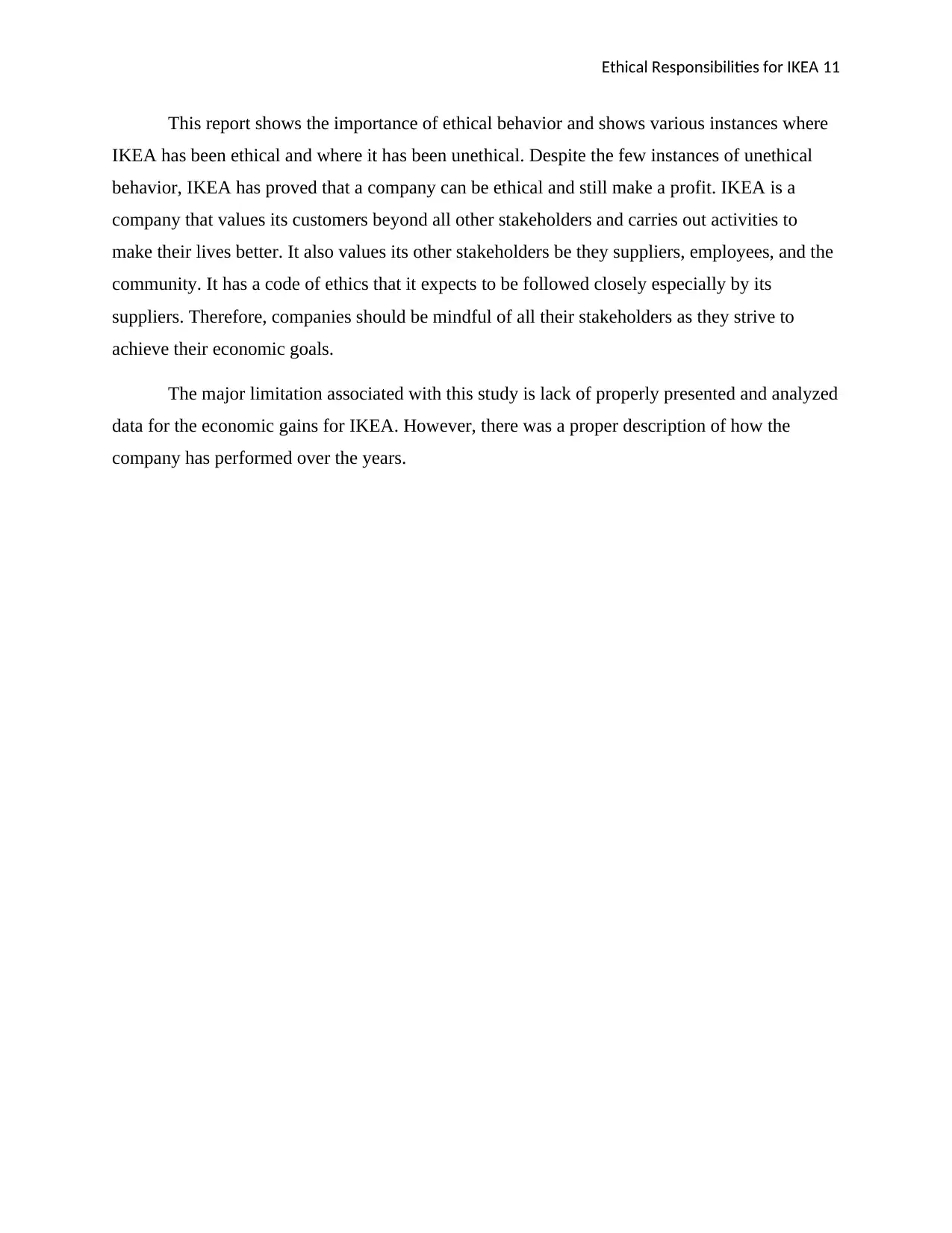
Ethical Responsibilities for IKEA 11
This report shows the importance of ethical behavior and shows various instances where
IKEA has been ethical and where it has been unethical. Despite the few instances of unethical
behavior, IKEA has proved that a company can be ethical and still make a profit. IKEA is a
company that values its customers beyond all other stakeholders and carries out activities to
make their lives better. It also values its other stakeholders be they suppliers, employees, and the
community. It has a code of ethics that it expects to be followed closely especially by its
suppliers. Therefore, companies should be mindful of all their stakeholders as they strive to
achieve their economic goals.
The major limitation associated with this study is lack of properly presented and analyzed
data for the economic gains for IKEA. However, there was a proper description of how the
company has performed over the years.
This report shows the importance of ethical behavior and shows various instances where
IKEA has been ethical and where it has been unethical. Despite the few instances of unethical
behavior, IKEA has proved that a company can be ethical and still make a profit. IKEA is a
company that values its customers beyond all other stakeholders and carries out activities to
make their lives better. It also values its other stakeholders be they suppliers, employees, and the
community. It has a code of ethics that it expects to be followed closely especially by its
suppliers. Therefore, companies should be mindful of all their stakeholders as they strive to
achieve their economic goals.
The major limitation associated with this study is lack of properly presented and analyzed
data for the economic gains for IKEA. However, there was a proper description of how the
company has performed over the years.
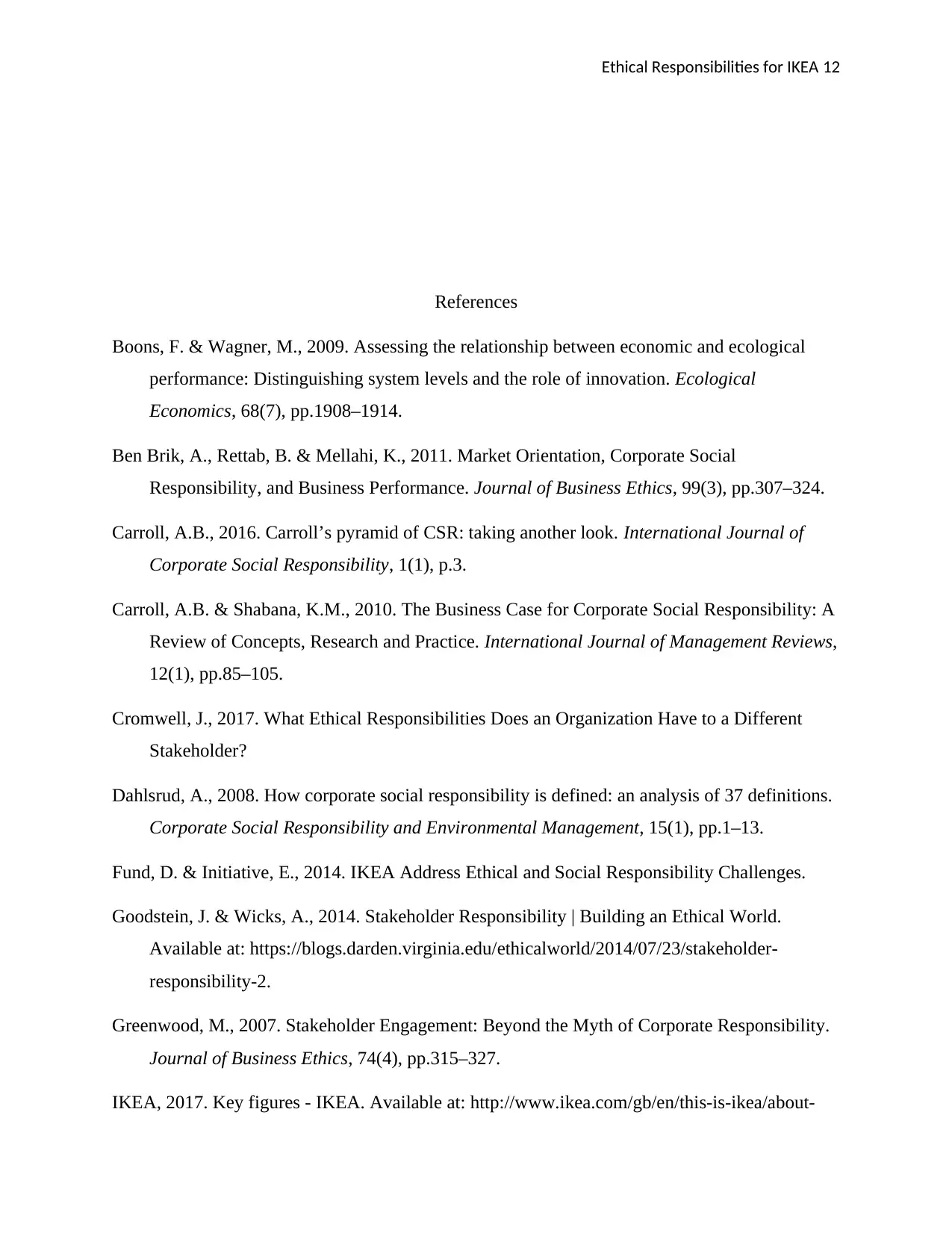
Ethical Responsibilities for IKEA 12
References
Boons, F. & Wagner, M., 2009. Assessing the relationship between economic and ecological
performance: Distinguishing system levels and the role of innovation. Ecological
Economics, 68(7), pp.1908–1914.
Ben Brik, A., Rettab, B. & Mellahi, K., 2011. Market Orientation, Corporate Social
Responsibility, and Business Performance. Journal of Business Ethics, 99(3), pp.307–324.
Carroll, A.B., 2016. Carroll’s pyramid of CSR: taking another look. International Journal of
Corporate Social Responsibility, 1(1), p.3.
Carroll, A.B. & Shabana, K.M., 2010. The Business Case for Corporate Social Responsibility: A
Review of Concepts, Research and Practice. International Journal of Management Reviews,
12(1), pp.85–105.
Cromwell, J., 2017. What Ethical Responsibilities Does an Organization Have to a Different
Stakeholder?
Dahlsrud, A., 2008. How corporate social responsibility is defined: an analysis of 37 definitions.
Corporate Social Responsibility and Environmental Management, 15(1), pp.1–13.
Fund, D. & Initiative, E., 2014. IKEA Address Ethical and Social Responsibility Challenges.
Goodstein, J. & Wicks, A., 2014. Stakeholder Responsibility | Building an Ethical World.
Available at: https://blogs.darden.virginia.edu/ethicalworld/2014/07/23/stakeholder-
responsibility-2.
Greenwood, M., 2007. Stakeholder Engagement: Beyond the Myth of Corporate Responsibility.
Journal of Business Ethics, 74(4), pp.315–327.
IKEA, 2017. Key figures - IKEA. Available at: http://www.ikea.com/gb/en/this-is-ikea/about-
References
Boons, F. & Wagner, M., 2009. Assessing the relationship between economic and ecological
performance: Distinguishing system levels and the role of innovation. Ecological
Economics, 68(7), pp.1908–1914.
Ben Brik, A., Rettab, B. & Mellahi, K., 2011. Market Orientation, Corporate Social
Responsibility, and Business Performance. Journal of Business Ethics, 99(3), pp.307–324.
Carroll, A.B., 2016. Carroll’s pyramid of CSR: taking another look. International Journal of
Corporate Social Responsibility, 1(1), p.3.
Carroll, A.B. & Shabana, K.M., 2010. The Business Case for Corporate Social Responsibility: A
Review of Concepts, Research and Practice. International Journal of Management Reviews,
12(1), pp.85–105.
Cromwell, J., 2017. What Ethical Responsibilities Does an Organization Have to a Different
Stakeholder?
Dahlsrud, A., 2008. How corporate social responsibility is defined: an analysis of 37 definitions.
Corporate Social Responsibility and Environmental Management, 15(1), pp.1–13.
Fund, D. & Initiative, E., 2014. IKEA Address Ethical and Social Responsibility Challenges.
Goodstein, J. & Wicks, A., 2014. Stakeholder Responsibility | Building an Ethical World.
Available at: https://blogs.darden.virginia.edu/ethicalworld/2014/07/23/stakeholder-
responsibility-2.
Greenwood, M., 2007. Stakeholder Engagement: Beyond the Myth of Corporate Responsibility.
Journal of Business Ethics, 74(4), pp.315–327.
IKEA, 2017. Key figures - IKEA. Available at: http://www.ikea.com/gb/en/this-is-ikea/about-
⊘ This is a preview!⊘
Do you want full access?
Subscribe today to unlock all pages.

Trusted by 1+ million students worldwide
1 out of 14
Related Documents
Your All-in-One AI-Powered Toolkit for Academic Success.
+13062052269
info@desklib.com
Available 24*7 on WhatsApp / Email
![[object Object]](/_next/static/media/star-bottom.7253800d.svg)
Unlock your academic potential
Copyright © 2020–2025 A2Z Services. All Rights Reserved. Developed and managed by ZUCOL.





